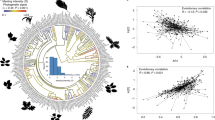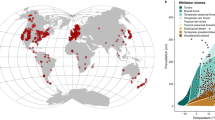Abstract
Rowan, Sorbus aucuparia L., exhibits conspicuous geographic variation in its inter-annual patterns of reproduction across southern Norway. Along the southern west coast, trees flower and produce clusters of succulent berries every other year, while in the east, trees mast every 3 years. We investigate two hypotheses for this variation: local adaptation to environmental conditions that favors different reproductive schedules at different locations or variation arising from single stereotyped reproductive strategy in the face of a geographic variation in productivity. To assess the theoretical plausibility of each of these hypotheses, we develop a refined resource budget model for mast reproduction. The refined model assumes that there is a lower bound on the amount of resource that may be allocated to reproduction, which allows the prediction of the relation between reproductive schedules and productivity. From the analysis of the model, we find that the observed geographic transition in rowan mast is caused if either productivity in the east is lower than that in the west or if plants in the eastern populations have evolved to pause reproduction until energy reserves are replenished to higher levels. The prediction by the productivity gradient hypothesis match with the empirical finding that the productivity is, in fact, likely to be lower in the east than the west, although we lack empirical data to test the likelihood of the local adaptation hypothesis. There is a need for experimental studies to clarify the validity of the local adaptation hypothesis.




Similar content being viewed by others
References
Ashton PS, Givnish TJ, Appanah S (1988) Staggered flowering in the Dipterocarpacear: new insights into floral induction and the evolution of mast fruiting in the aseasonal tropics. Am Nat 132:44–66
Boutin S, Wauters LA, McAdam AG, Humphries MM, Tosi G, Dhondt AA (2006) Anticipatory reproduction and population growth in seed predators. Science 314:1928–1930
Crone EE, Polansky L, Lesica P (2005) Empirical models of pollen limitation, resource acquisition, and mast seeding by a bee-pollinated wildflower. Am Nat 166:396–408
Dieckmann U, Law R, Metz JAJ (2000) The geometry of ecological interactions: simplifying spatial complexity. Cambridge University Press, Cambridge, UK
Hanski I (1999) Metapopulation ecology. Oxford University Press, Oxford, UK
Herrera CM, Jordano P, Guitian J, Traveset A (1998) Annual variability in seed production by woody plants and the masting concept: reassessment of principles and relationship to pollination and seed dispersal. Am Nat 152:576–594
Ims RA (1990) The ecology and evolution of reproductive synchrony. Trends Ecol Evol 5:135–140
Isagi Y, Sugimura K, Sumida A, Ito H (1997) How does masting happen and synchronize? J Theor Biol 187:231–239
Janzen DH (1971) Seed predation by animals. Annu Rev Ecol Syst 2:465–492
Kelly D (1994) The evolutionary ecology of mast seeding. Trends Ecol Evol 9:465–470
Kelly D, Sork VL (2002) Mast seeding in perennial plants: why, how, where? Annu Rev Ecol Syst 33:427–447
Kelly D, Harrison AL, Lee WG, Payton IJ, Wilson PP, Schauber WM (2000) Predator satiation and extreme mast seeding in 11 species of Chionochloa (Poaceae). Oikos 90:477–488
Kelly D, Hart DE, Allen RB (2001) Evaluating the wind-pollination benefits of mast seeding. Ecology 82:117–126
Kobro S, Søreide L, Djønne E, Rafoss T, Jaastad G, Witzgall P (2003) Masting of rowan Sorbus aucuparia L. and consequences for the apple fruit moth Argyresthia conjugella Zeller. Popul Ecol 45:25–30
Koenig WD, Knops JMH (1998) Scale of mast-seeding and tree-ring growth. Nature 396:225–226
Koenig WD, Knops JMH (2000) Patterns of annual seed production by northern hemisphere trees: a global perspective. Am Nat 155:59–69
Koenig WD, Knops JMH (2005) The mystery of masting in trees. Am Sci 93:340–347
Koenig WD, Mumme RL, Carmen WJ, Stanback MT (1994) Acorn production by oaks in central coastal California: variation within and among years. Ecology 75:99–109
Kon H, Noda T, Terazawa K, Koyama H, Yasaka M (2005) Evolutionary advantages of mast seeding in Fagus crenata. J Ecol 93:1148–1155
Liebhold A, Sork VL, Peltonen M, Koenig W, Bjørnstad ON, Westfall R, Elkinton J, Knops JMH (2004) Within-population spatial synchrony in mast seeding of North American oaks. Oikos 104:156–164
Norton DA, Kelly D (1988) Mast seeding over 33 years by Dacrydium cupressinum Lamb. (rimu) (Podocarpaceae) in New Zealand: the importance of economies of scale. Funct Ecol 2:399–408
Ostfeld RS, Keesing F (2000) Pulsed resources and community dynamics of consumers in terrestrial ecosystems. Trends Ecol Evol 15:232–237
Ostfeld RS, Jones CG, Wolff JO (1996) Of mice and mast: ecological connections in eastern deciduous forests. Bioscience 46:323–330
Richardson SJ, Allen RB, Whitehead D, Carswell FE, Ruscoe WA, Platt KH (2005) Climate and net carbon availability determine temporal patterns of seed production by Nothofagus. Ecology 86:972–981
Rees M, Kelly D, Bjørnstad ON (2002) Snow tussocks, chaos, and the evolution of mast seeding. Am Nat 160:44–59
Satake A, Bjørnstad ON (2004) Spatial dynamics of specialist seed predators on synchronized and intermittent seed production of host plants. Am Nat 163:591–605
Satake A, Bjørnstad ON, Kobro S (2004) Masting and trophic cascades: interplay between rowan trees, apple fruit moth, and their parasitoid in southern Norway. Oikos 104:540–550
Satake A, Iwasa Y (2000) Pollen coupling of forest trees: forming synchronized and periodic reproduction out of chaos. J Theor Biol 203:63–84
Satake A, Iwasa Y (2002a) Spatially limited pollen exchange and a long-range synchronization of trees. Ecology 83:993–1005
Satake A, Iwasa Y (2002b) The synchronized and intermittent reproduction of forest trees is mediated by the Moran effect, only in association with pollen coupling. J Ecol 90:830–838
Schauber EM, Kelly D, Turchin P, Simon C, Lee WG, Allen RB, Payton IJ, Wilson PR, Cowan PE, Brockie RE (2002) Masting by eighteen New Zealand plant species: the role of temperature as a synchronizing cue. Ecology 83:1214–1225
Shibata M, Tanaka H, Nakashizuka T (1998) Causes and consequences of mast seed production of four co-occurring Carpinus species in Japan. Ecology 79:54–64
Sork VL, Bramble J, Sexton O (1993) Ecology of mast-fruiting in three species of north American deciduous oaks. Ecology 74:528–541
Sperens U (1997) Fruit production in Sorbus aucuparia L. (Rosaceae) and pre-dispersal seed predation by the apple fruit moth (Argyresthia conjugella Zell.). Oecologia 110:368–373
Suzuki W, Osumi K, Masaki T (2005) Mast seeding and its spatial scale in Fagus crenata in northern Japan. For Ecol Manag 205:105–116
Tilman D, Kareiva P (eds) (1997) Spatial ecology: the role of space in population dynamics and interspecific interactions. Princeton University Press, Princeton, New Jersey
Yasaka M, Terazawa K, Koyama H, Kon H (2003) Masting behavior of Fagus crenata in northern Japan: spatial synchrony and pre-dispersal seed predation. For Ecol Manag 184:277–284
Acknowledgments
This work was supported in part by a grant-in-aid from the Ministry of Education, Science, Sports, and Culture, Japan, and the Japan Society for the Promotion of Science (A.S.), and the US Department of Agriculture National Research Initiative (NRI) grant nos. 2002-35302-12656 and 2006-35302-17419 (O.B.). We thank Sverre Kobro for providing the rowan time series data.
Author information
Authors and Affiliations
Corresponding author
Additional information
Akiko Satake is the recipient of the 11th Denzaburo Miyadi Award.
About this article
Cite this article
Satake, A., Bjørnstad, O.N. A resource budget model to explain intraspecific variation in mast reproductive dynamics. Ecol Res 23, 3–10 (2008). https://doi.org/10.1007/s11284-007-0397-5
Received:
Accepted:
Published:
Issue Date:
DOI: https://doi.org/10.1007/s11284-007-0397-5




